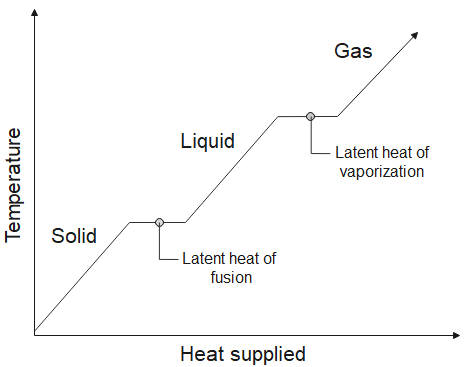
What is meant by latent heat? How will the state of matter transform if latent heat is given off?
Answer
453.9k+ views
Hint: Latent heat is the heat that is required to convert a solid into a liquid or liquid into gas. It is the heat energy released or absorbed during the phase change of the substance without a change in temperature of the substance i.e. temperature remains constant.
Complete answer:
Latent heat is defined as the heat needed to change the state of matter of a substance. It is the heat supplied from the surroundings to the substance to convert a solid into a liquid or to a vapor (gas) or a liquid into a gas. It is the heat given off to the surroundings from the substance to convert a liquid into a solid or to liquefy a gas into a liquid state. The figure below shows the temperature versus heat supplied graph.

There are two types latent heat,
1. Latent heat of Fusion – It is the heat absorbed when solid melts into liquid (For example, ice melts into water, heat is absorbed) or the heat released when liquid turns into solid (For example, water freezes into ice, heat is released). The temperature of the substance is constant during the entire process.
2. Latent heat of vaporization– It is the heat absorbed when liquid turns into gas (For example, water vaporizes into water vapor, heat is absorbed) or the heat released when gas turns into liquid (For example, water vapor condenses into water, heat is released). The temperature of the substance is constant during the entire process.
Latent heat L is given by,
$L=\dfrac{Q}{m}$
Where, Q is the heat energy released or absorbed during the phase change of the substance and m is the mass of the substance.
If latent heat is given off, the substance in liquid state will be converted into solid state and the substance in gas or vapor state will be converted into liquid state. Here, the heat released is given off from the internal energy of the substance to its surroundings, therefore the internal energy decreases.
Note:
Latent heat is heat energy released or absorbed per unit mass of the substance, its unit is Joules or calories i.e. amount of heat per unit mass of the substance that is undergoing the phase change with temperature of substance remaining constant during the process.
Complete answer:
Latent heat is defined as the heat needed to change the state of matter of a substance. It is the heat supplied from the surroundings to the substance to convert a solid into a liquid or to a vapor (gas) or a liquid into a gas. It is the heat given off to the surroundings from the substance to convert a liquid into a solid or to liquefy a gas into a liquid state. The figure below shows the temperature versus heat supplied graph.

There are two types latent heat,
1. Latent heat of Fusion – It is the heat absorbed when solid melts into liquid (For example, ice melts into water, heat is absorbed) or the heat released when liquid turns into solid (For example, water freezes into ice, heat is released). The temperature of the substance is constant during the entire process.
2. Latent heat of vaporization– It is the heat absorbed when liquid turns into gas (For example, water vaporizes into water vapor, heat is absorbed) or the heat released when gas turns into liquid (For example, water vapor condenses into water, heat is released). The temperature of the substance is constant during the entire process.
Latent heat L is given by,
$L=\dfrac{Q}{m}$
Where, Q is the heat energy released or absorbed during the phase change of the substance and m is the mass of the substance.
If latent heat is given off, the substance in liquid state will be converted into solid state and the substance in gas or vapor state will be converted into liquid state. Here, the heat released is given off from the internal energy of the substance to its surroundings, therefore the internal energy decreases.
Note:
Latent heat is heat energy released or absorbed per unit mass of the substance, its unit is Joules or calories i.e. amount of heat per unit mass of the substance that is undergoing the phase change with temperature of substance remaining constant during the process.
Recently Updated Pages
The correct geometry and hybridization for XeF4 are class 11 chemistry CBSE

Water softening by Clarks process uses ACalcium bicarbonate class 11 chemistry CBSE

With reference to graphite and diamond which of the class 11 chemistry CBSE

A certain household has consumed 250 units of energy class 11 physics CBSE

The lightest metal known is A beryllium B lithium C class 11 chemistry CBSE

What is the formula mass of the iodine molecule class 11 chemistry CBSE

Trending doubts
State the laws of reflection of light

One Metric ton is equal to kg A 10000 B 1000 C 100 class 11 physics CBSE

Difference Between Prokaryotic Cells and Eukaryotic Cells

How do I convert ms to kmh Give an example class 11 physics CBSE

Describe the effects of the Second World War class 11 social science CBSE

Which of the following methods is suitable for preventing class 11 chemistry CBSE




